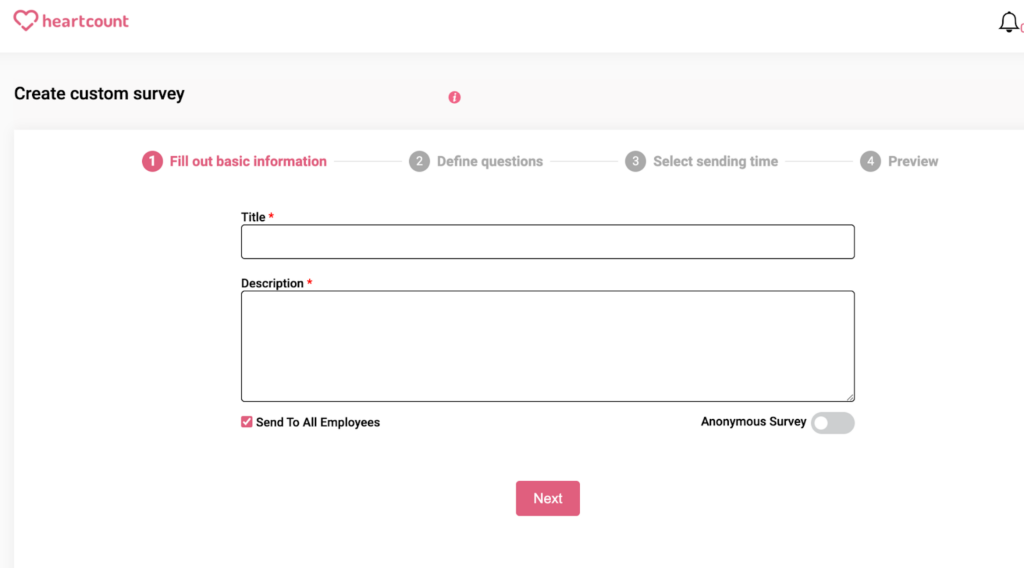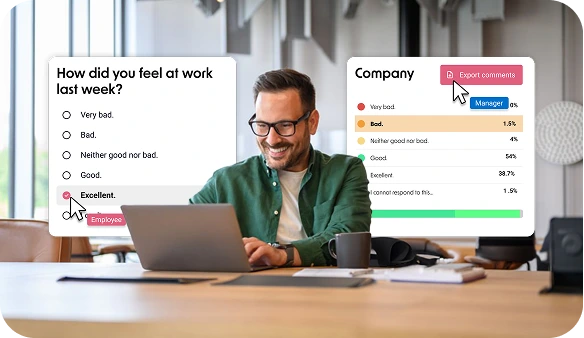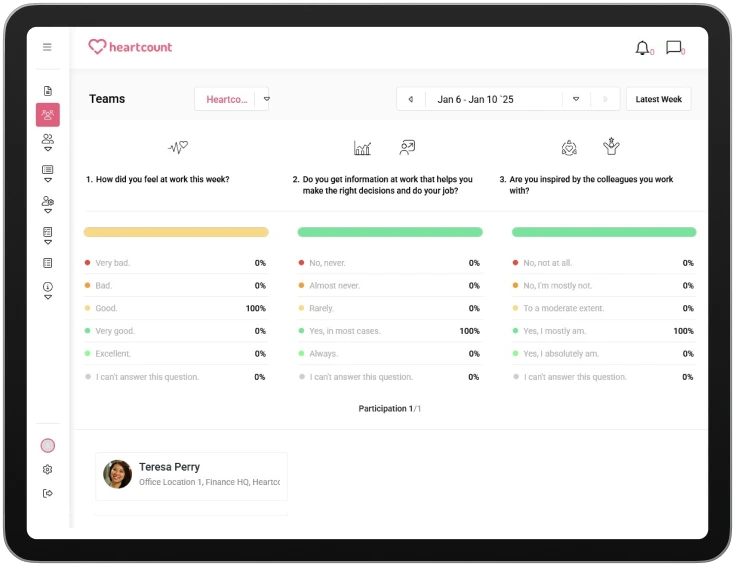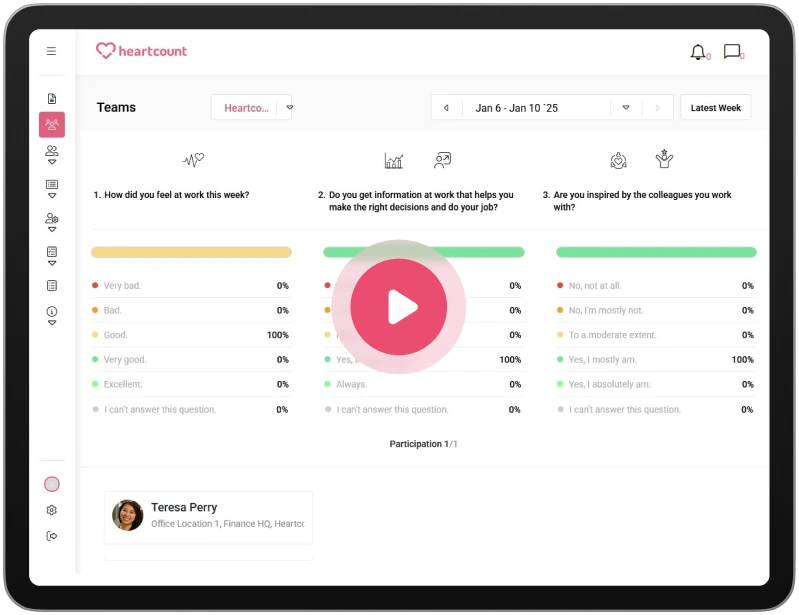Anonymous vs confidential survey: What is the difference, and why do you need them both?

Many employees feel nervous about workplace surveys, worrying that their responses might reach their managers and lead to negative outcomes. This anxiety makes them less likely to provide honest feedback.
Choosing the right survey type—anonymous or confidential—affects not only the quality of the feedback but also the overall workplace culture because it influences how safe employees feel when sharing their opinions.
Anonymous surveys keep identities hidden and make employees feel safer. Confidential surveys link feedback to individuals but protect their privacy from unauthorized access and allow follow-up.
-
1.What is an anonymous survey?
-
2.What is a confidential survey?
-
3.Anonymous vs confidential survey at work
-
4.Why is it important to be transparent about your employee surveys?
-
5.When to use each type of survey?
-
6.What are the limitations of anonymous surveys in gathering accurate data?
-
7.How to make an anonymous and confidential survey?
Many employees feel nervous about workplace surveys, worrying that their responses might reach their managers and lead to negative outcomes. This anxiety makes them less likely to provide honest feedback.
Choosing the right survey type—anonymous or confidential—affects not only the quality of the feedback but also the overall workplace culture because it influences how safe employees feel when sharing their opinions.
Anonymous surveys keep identities hidden and make employees feel safer. Confidential surveys link feedback to individuals but protect their privacy from unauthorized access and allow follow-up.
What is an anonymous survey?
An anonymous survey allows employees to give feedback without revealing their identity. The answers cannot be traced back to the individual, which ensures total privacy. Names, emails, job positions, or employee IDs aren’t identified, and therefore, it’s impossible to know who provided which response.
As a result, employees feel more comfortable sharing open and honest feedback without worrying about consequences.
Anonymous surveys are particularly useful when you’re gathering sensitive information on employee sentiment or when trust within the organization is low. By ensuring anonymity, you can collect genuine insights that reflect the real concerns and feelings of your employees.
Gemma Hood, CEO and Founder of Culturehood, a platform for cultural growth and workplace improvement, supports anonymous feedback but warns:
“While anonymity can empower employees to speak candidly without fear of retribution, for added value, it should not be the default mode of feedback. Open dialogue and trust between employees and management are essential for fostering a healthy work environment where individuals feel safe expressing their opinions openly.”
Anonymous survey example
Google wanted to hear what its employees thought about the company, so they created an anonymous yearly survey called “Googlegeist” to gather feedback.
The survey usually takes 30 minutes to complete, but almost all employees participate—88% or more. The high response rate is impressive and allows workers to share their thoughts on pay, management, and the company’s direction.
The feedback has led to real changes, such as when former CEO Eric Schmidt increased base salaries because of employee suggestions.
In the end, while Googlegeist is a great way to gather feedback, we have to emphasize two things:
- The importance of helping employees feel safe enough to provide honest responses
- Making sure the company acts on employee feedback to improve their satisfaction
What is a confidential survey?
A confidential survey connects responses to the employee’s identity, but access to that information is restricted.
The system or organization that conducts the survey can identify who submitted each response, but strict rules prevent unauthorized people, like direct supervisors, from viewing individual answers. Instead, responses are analyzed in larger groups, such as by department or region, which helps keep individual identities hidden.
Confidential surveys allow for more detailed feedback and follow-up while protecting employees’ privacy. They allow organizations to address specific concerns and track trends over time while maintaining a level of security that employees can trust.
Confidential survey example
A large multinational manufacturing company with over 16,000 employees in 41 locations across 8 countries needed to measure employee engagement. It wanted to collect honest, unbiased employee feedback, so it sought a third-party partner who could administer a confidential and secure survey.
Confidentiality was critical to ensure that employees felt safe sharing their true opinions without fear of negative consequences, leading to more reliable and accurate data.
The Beacon Group created a confidential, six-step survey process that included survey design, translation into 20+ languages, and anonymous collection, both online and on paper. They provided detailed reports and analyses to help the company improve.
The company has conducted the employee engagement survey annually for over ten years. Some key outcomes include:
- More employees are participating each year.
- Local management is held accountable based on the survey results.
- Employee engagement and organizational performance have steadily improved over time.
- The survey has helped local managers improve their leadership and communication skills.
By ensuring confidentiality, The Beacon Group collected honest feedback, which helped the company continuously improve and build a stronger, more engaged workforce.
COLLECT
Anonymous vs confidential survey at work
In the workplace, anonymous and confidential surveys offer different ways to collect employee feedback. Each method has pros and cons, and the choice between them can impact how comfortable employees feel about sharing their honest opinions and how useful the results are for the company.
With anonymous surveys, responses cannot be traced back to the individual. This method is ideal when employees are hesitant to give feedback, especially on sensitive topics. The anonymity encourages more honesty, but it can also limit follow-up, making it difficult to address specific issues. Additionally, because there is no link between the feedback and the person, organizations may miss important contexts that could help interpret the data better.
Confidential surveys, on the other hand, link responses to individuals but protect that information from unauthorized access. Employees’ answers are only visible in the aggregate, grouped by factors like department or location, which still provides privacy while allowing more detailed analysis. Confidential surveys allow follow-ups on specific feedback and help track trends over time. However, employees may still feel cautious if they don’t fully trust that their responses will remain secure.
Here’s a comparison of the two:
| Anonymous survey | Confidential survey | |
| Identity reveal | Not possible for anyone | Yes, but protected from unauthorized access |
Honesty | High, as employees feel utterly secure that no one knows their identity | Moderate, depends on employee trust |
| Follow up | Not possible | Possible for specific issues |
| Data analysis | Limited to overall trends | Provides more detailed insights |
| Best for | Highly sensitive topics, low trust work environments | More detailed feedback, tracking long-term trends |
As you can see, both survey types are valuable, but the choice depends on the specific needs of the company and the nature of the feedback it wants to collect.
With HeartCount, you can create custom surveys with the option to choose whether they will be anonymous or not.

Why is it important to be transparent about your employee surveys?
A LinkedIn poll showed that 57% of employees believe their surveys aren’t confidential, and only 41% feel they can be completely honest. Lack of trust means employees may hold back their true thoughts. To fix this issue, companies need to be transparent about their surveys.
Transparency in employee surveys is important as it:
- Builds trust
- Encourages honest feedback
- Improves the credibility of the survey process
Being clear about whether a survey is anonymous or confidential helps reduce the anxiety employees might feel about potential repercussions. It also improves employee participation.
Employees who don’t fully understand how their information will be used may withhold feedback or provide less honest answers, which can skew results.
Transparency ensures they feel safe to speak up without fear.
When you explain the survey process, it shows employees that the company wants to use their feedback to make the workplace better, not just gather data for appearance’s sake. It helps employees feel like their opinions matter and will lead to real changes, which leads to higher morale, productivity, and engagement.
In the long run, being transparent about your surveys helps create a more open work environment. It shows respect for employees’ privacy and builds trust. Openness can lead to more people taking part in the surveys, better feedback, and stronger trust between employees and leaders.
When to use each type of survey?
The choice between an anonymous or confidential survey depends on:
- The type of information you need
- The level of detail you need from the responses
- The situation you’re dealing with
- Organizational goals
Anonymous surveys are best when you’re asking about sensitive topics, like employee satisfaction or workplace culture, where employees might worry about being identified. Since their identities are protected, people are more likely to be honest and open. This is helpful when you need candid feedback and aren’t concerned about following up or linking responses to specific departments.
Confidential surveys are ideal when you want to gather more detailed feedback, track trends over time, or target specific issues within teams. In confidential surveys, responses are linked to individuals but are protected from unintended viewers. This method works well if you’re planning to act on specific feedback — for example, reducing employee turnover — or need to follow up for more details. However, employees must trust that their privacy is maintained for these surveys to be effective.
In summary:
- Use anonymous survey for sensitive issues where complete privacy is necessary to encourage honest feedback.
- Use a confidential survey when you need more detailed data that can be connected to specific groups or used for follow-up actions.
UNDERSTAND
What are the limitations of anonymous surveys in gathering accurate data?
Anonymous surveys can be very useful, but they have some limitations when it comes to gathering accurate and actionable data:
- No follow-ups: Since anonymous surveys don’t collect personal information, it’s impossible to follow up for clarification or additional insights. This can be a major drawback if you want to explore specific issues further or if you need to act on negative feedback. Without knowing who made a comment, you can’t get more details to better understand the problem.
- Data accuracy issues: Anonymous surveys are vulnerable to false data. Some people may not take the survey seriously or may even provide misleading responses, knowing they won’t be held accountable. This can reduce the accuracy of the data and skew the results.
- Limited context: Anonymous surveys often collect general data without the context needed to understand specific situations. For example, negative comments may not provide enough detail to address the root of a problem, making it hard to take effective action. Without knowing who is giving feedback, it’s challenging to link responses to particular teams or departments.
- Less actionable insights: Because you can’t identify who submitted the feedback, it’s difficult to create targeted action plans. Anonymous responses provide a snapshot of general sentiment but don’t allow for tailored interventions, which are often necessary to solve specific issues.
Despite these limitations, anonymous surveys are still valuable when it’s important to encourage honest, candid responses, especially on sensitive topics. However, the inability to follow up and the risk of skewed data must be considered when deciding whether to use this type of survey.
What are the considerations for data analysis in confidential surveys?
When analyzing data from confidential surveys, consider the following factors to make sure the process is effective and secure:
- Data security: One of the main concerns is protecting the data, as it contains identifiable information about the participants. To prevent breaches, you must make sure that only authorized people can access the data. Use secure platforms to collect and store the responses and establish strong privacy policies.
- Handling identifiable information: Since confidential surveys link responses to individual employees, you must handle this information carefully. Keep personal information private and use it for the intended purpose, like improving the workplace or addressing specific issues. Employees must trust that their identities will not be revealed to managers or coworkers unless absolutely necessary.
- Follow-up for deeper insights: One of the main advantages of confidential surveys is the ability to follow up on responses. If you identify an issue, you can reach out to employees for more details. This allows for a deeper understanding of the problems and helps create targeted solutions. However, you have to protect the employee’s identity during this process.
How to make an anonymous and confidential survey?
Creating anonymous and confidential surveys requires careful planning to ensure you gather valuable feedback while protecting participants’ privacy.
Here’s a step-by-step guide to help you create both types of surveys.
1. Define your survey goals
Before creating the survey, decide what kind of feedback you need and how it will be used. Ask yourself:
- Do I need detailed, identifiable responses, or will general feedback work?
- Will I need to follow up with specific individuals?
Your goals will determine whether you need an anonymous or confidential survey.
2. Choose the type of survey
Make an anonymous survey when you want honest, candid feedback without identifying the respondent. It’s ideal for sensitive topics or when employees may feel uncomfortable sharing their thoughts.
Choose a confidential survey when you need to know who responded but still want to ensure their data is protected. Confidential surveys are helpful if you want to follow up with specific employees for more details.
3. Create clear questions
For both types of surveys, keep questions clear and simple.
In anonymous surveys, avoid questions that might indirectly reveal someone’s identity, like asking about their department if the group is small.
You can ask more detailed questions in confidential surveys, but be mindful not to invade privacy. Be transparent about how you’ll use their information and explain that their identity is protected.
Workplace transparency builds trust, encourages openness, and reduces stress, leading to higher satisfaction, better performance, and lower turnover, strengthening the benefits of employee engagement.
4. Select the right tools
To create surveys, you’ll need a platform that supports either anonymous or confidential feedback. Choose a tool that offers strong data security and an easy-to-use interface.
We recommend HeartCount, an employee experience platform that provides both anonymous and confidential surveys. HeartCount allows you to easily create and manage surveys while ensuring privacy and security for your employees. It also offers insights and reports to help you analyze the data effectively.
In addition to anonymous and confidential surveys, HeartCount also offers 360-degree feedback, pulse surveys, and custom employee satisfaction surveys.
These options give businesses flexibility in gathering diverse feedback while ensuring privacy and actionable insights.

5. Ensure privacy settings are correct
Make sure the survey platform doesn’t track identifying details like names, email addresses, or IP addresses for anonymous surveys. Double-check that the data collected cannot be traced back to any individual.
Use secure settings to store personal information safely and ensure that only authorized personnel have access to the data for confidential surveys.
6. Test the survey
Before sending the survey to everyone, run a test with a small group of employees. Testing makes sure that the survey works properly, including the questions and how it looks. It also helps check that privacy settings are set correctly.
This way, you can fix any problems before the survey goes out to the whole company and ensure it runs smoothly for all participants.
7. Send the survey
Once your survey is ready, distribute it to your employees. In your communication, be clear about whether the survey is anonymous or confidential, and explain why you’re using that type of survey. This will build trust and encourage honest participation.
Creating a space where employees feel safe to share their thoughts is key to improving the employee experience, a crucial part of managing a healthy workplace.
8. Analyze the results
For anonymous surveys, focus on spotting trends and general patterns in the feedback. Since you can’t trace responses to specific people, look for common issues or concerns that affect multiple employees. You will understand the broader picture, although you won’t be able to address individual comments directly or follow up on specific feedback.
In confidential surveys, the data allows for more detailed analysis. You can group the feedback by departments or teams and pinpoint issues in specific areas of the company. If needed, you can follow up with certain employees to get more details while still keeping their identities private. Just make sure that personal information stays protected throughout the process.
Start gathering honest employee feedback with HeartCount
Both anonymous and confidential surveys are valuable in gathering honest employee feedback.
- Use anonymous surveys when you want employees to feel completely safe sharing their thoughts without anyone knowing who they are. This is great for sensitive topics where people might not feel comfortable attaching their names.
- Use confidential surveys when it’s okay for a few trusted people (like HR or management) to know who gave the feedback, but you still want the results to be kept private from the wider group. This is useful when follow-up might be needed based on individual responses.
By choosing the right type of survey, you can build trust, gain valuable insights, and improve workplace culture. To begin enhancing your employee feedback system, explore HeartCount. It offers both anonymous and confidential survey options, helping you collect honest, actionable data.











